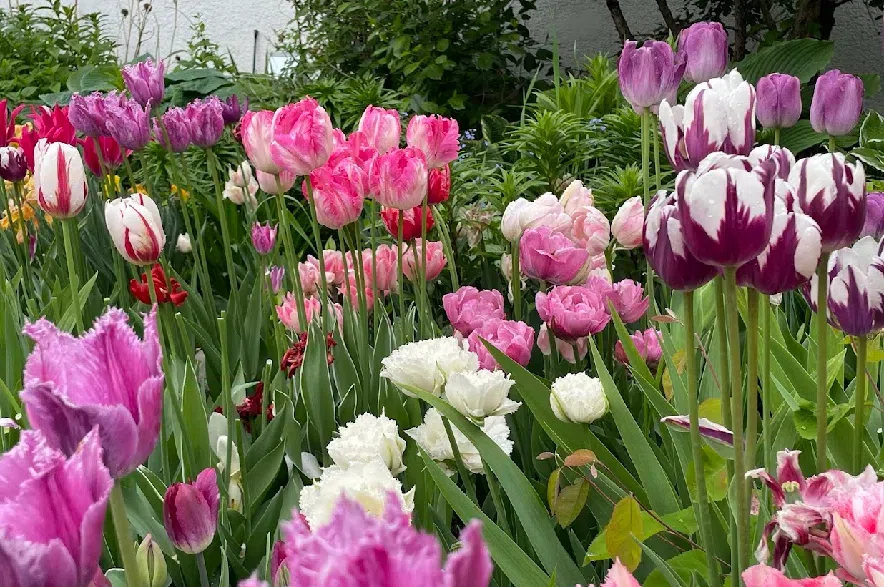Jill and Rick Van Duyvendyk answer all your gardening questions in Garden Talk on 650 CKOM and 980 CJME every Sunday morning from 9 a.m. to 11 a.m.
Here are some questions and answers from the Sept. 22 show:
Q: What do I need to know about planting tulips in Saskatchewan?
A: Tulips need to be in a full sun location so that the ground heats up in early spring so on the west or south side of a house is ideal. Plant them about seven or eight inches down and then check your soil. If your soil is heavy clay, add some sharp sand to the base for more drainage. You don’t want tulip bulbs sitting in water or heavy clay soil. The first year they might be okay, but then over time they’ll slowly rot.
Read Dutch Growers guide to planting spring bulbs in fall here.
Q: When and how do I plant garlic?
A: Garlic can be planted in fall. Break the cloves apart and plant with the hard, crusty side where the root was down and the pointy side up. Plant them about a hand-width apart ineven rows about four inches deep.
Q: When do I harvest garlic?
A: Harvest in September when you can bend the stalks over. The top of the stalks will stiff, but when they start laying over a little bit, then harvest them.
Q: Are there any vegetables I can plant in Saskatchewan in fall for a crop next year?
A: Garlic is one, but there’s not a whole lot. Chives as well can be planted in fall. There’s also asparagus, but that takes about three years to start producing.
Q: Can I prune my apple trees in late September? Is there a trick if you’re having trouble getting fruit or flowers?
A: Could you prune them now a little bit lightly or should we should we wait just till afterwards? Wait until the leaves fall off in October or the first part of November. Cut them back by at least one third. If you want to top them, do it when they start putting on new growth in spring. Every time you cut a branch at the top, the tree will put out two or three more branches, called water sprouts. If that happens,trim them back to one again in summer.
Q: How to I care for a mandevilla in my Saskatchewan garden in fall and winter?
A: It is a tropical plants so once night temperatures get below 5 deg C bring it indoors and cut it back to maybe about one or two feet. Cut any tendrils right back. Give it a good spray with End All or Safer’s Insecticidal Soap and do three treatments 10 to 15 days apart. You can also keep trimming it in the winter because the lack of light will mean the branches stretch. Keep it short. Use a grow light for eight to 10 hours a day.
Read more
- Garden Talk: Should weeds in new lawns be removed?
- Garden Talk: How to deal with a lily beetle invasion
- Garden Talk: To prune or not to prune?
- Garden Talk: Do purple apples really grow in Saskatchewan?
Q: Can I use a mixture of one to four peroxide and water to spray soil to control bugs?
A: It definitely does work. Make sure you don’t make the mix too strong. It’s a great home remedy
Q: I have a lot of winter kill in lawn. Would leaving leaves on my lawn help prevent this over the winter?
A: No, it can make it actually worse.You can get a lot more snow mold in it, so make sure you clear the leaves off it and cut it to about 1 1/2 inches and apply a fall fertilizer. I like GroundKeeper fertilizer because it has a bit of phosphorus, but it also has sulphur in it that will lower the pH and increase nutrients to make it more disease-resistant.
As the snow starts disappearing, even if only some of the grass is exposed, use a leaf rake to fluff up your grass. That’ll help get rid of snow mold and then you won’t have so much winter kill. If you start digging in too much, you will rip out all the grass up by the roots,. Just drag a light leaf rake along the grass.
Q: I was given some canna lilies and I had to take them out of the pot and cut them down. Can I still save those bulbs?
A: Ideally, you want cannas to die back, so if the leaves are still green reduce watering. When they start to look yellow cut them down and take them out of the pot. With ones you have already taken out of the pot that have no leaves, let the plants die back to the bulb. You can also shake that dirt off and lay the bulbs out to dry. Put them in a cold room in a box with some peat moss to make sure there is a little bit of moisture. Too much moisture will rot bulbs. Check about once a month so that they don’t go totally dry — you them dry, but not bone dry. You can also use sawdust.
Q: Why are the tips on my pine trees turning yellow?
A: You will see that on the inside needles and sometimes the tips every fall, depending on how dry it has been. It’s a natural thing, so nothing to worry about. Don’t water pine trees too much in fall, just water enough to keep them alive. Around the third week of October, give them one last good soak and that’s all you need to do until next spring, when you can start fertilizing with a 30-10-10 fertilizer every three weeks from about May 10. Stop around July 15.
A: Is fall too late to dethatch the lawn in Saskatchewan? Is it safe to use the tine blades in the lawnmower and how high should it be set?
A: Don’t dethatch until spring. If your lawn is very thick and green, you wouldn’t be able to get a dethacher through it anyway.
Q: What’s the best way to preserve or overwinter a coleus?
A: You can bring it in the house for winter. The life cycle of annuals is to grow, produce flowers that will turn into seed and then die. Most coleuses are hybrids, so a lot of their seeds are sterile, so they just keep reproducing. Make sure to cut off any seed heads yo keep the plant fuller and more lush. Water it like a house plant, and then take cuttings off the new growth in February or March and plant them out new plants. Take cuttings about 1 cm below a node and cut them on an angle. Make sure you have two or three nodes on your cutting before remove the bottom leaves, and putting it in water. You can take cuttings now from a live plant outside, and start to root them now and grow them slowly over the winter.
Q: Is ribbon grass invasive? If so, how would I contain it?
A: Ribbon grass can be invasive; it spreads through rhizomes in the ground. If you want to contain it, surround it with lawn edging that is at least four to five inches deep, or take a large nursery pot and plant that in the ground with the bottom cut out, and plant ribbon grass right in that. You won’t see the pot because the pot will be buried just under the surface of the soil, but it’ll be like a plastic barrier to stop it spreading. It will not survive winter in a pot above ground.
Q: My silver maple is growing branches from the base. Why is it doing that and can I stop it?
A: Prune those suckers off. If you keep them, they’re just going to just keep on growing like a little bush. Cut them right off at the base. You will get a few suckers every once in a while. It is possible the roots were nicked around the base when the tree was young, which will make it set suckers. Nothing’s going wrong with that tree, trimming suckers is a maintenance thing for an aesthetic look. There isn’t a way to prevent it from happening.
Q: I recently had a loved one pass away and their wish was to have their ashes mixed with potting soil in a gigantic flower pot and have flowers grown in it. Is this possible?
A: There’s no reason why that wouldn’t work. Mix the ashes with potting soil and plant as usual, or layered bulbs can work, too. Another possibility is placing the ashes and planting a tree. With a tree or a perennial bed you’re not changing out the soil over time. With an annual pot, eventually you’ll have to change out the soil.
Q: I planted hollyhock seeds in June and the plants only grew about four inches. Do I have to replant in the ground for next year, or should I start them in my house?
A: Hollyhocks take a long time to grow that first year. Starting them in your house in March is ideal. It doesn’t mean that the ones that you have in the ground right now aren’t going to do anything. They’re just slow starters. Let the frost hit them and when they die back cut them back down to the ground.
These questions and answers have been edited and condensed
Read more







